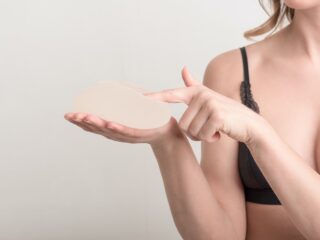 Capsular contracture, or the formation of scar tissue around an implant, is often considered one of the most intimidating potential complications after breast augmentation. In truth, many cases of capsular contracture only exhibit minor symptoms and the most mild forms of the condition can be asymptomatic. According to the American Society of Plastic Surgeons (ASPS), capsular contracture is typically divided into the following grades of severity:
Capsular contracture, or the formation of scar tissue around an implant, is often considered one of the most intimidating potential complications after breast augmentation. In truth, many cases of capsular contracture only exhibit minor symptoms and the most mild forms of the condition can be asymptomatic. According to the American Society of Plastic Surgeons (ASPS), capsular contracture is typically divided into the following grades of severity:
- Grade I: With the least severe form of capsular contracture, the breasts remain natural-looking and soft to the touch. The formation of scar tissue around the implant should not cause any visible or palpable symptoms.
- Grade 2: The breasts may exhibit some firmness or mild cosmetic indications of scar tissue, but they should still maintain a normal shape.
- Grade 3: Although pain is not usually experienced at this stage, the breasts exhibit obvious symptoms of capsular contracture. The breast shape may appear abnormal, being overly round and more highly positioned compared to an uninvolved breast. The breasts may also feel unusually firm.
- Grade 4: In addition to the cosmetic symptoms of grade three capsular contracture, the most severe form of the condition typically causes soreness, tenderness, or pain in the breasts.
If you suffer from the most severe form of capsular contracture, your breasts will likely feel hard and painful. If capsular contracture changes the look or feel of your breasts to the point of concern, the only remedy is breast revision surgery. Obviously, both you and board-certified plastic surgeon David Bottger, MD want to minimize your risk of capsular contracture and many patients wonder whether selecting one breast augmentation incision over another can help decrease the likelihood.
Incision Choice and Capsular Contracture
Nobody knows for sure what causes capsular contracture, but one of the popular theories is that capsular contracture can be caused by an implant’s exposure to bacteria. This exposure may or may not be increased by a patient’s choice of incision. For example, when the periareolar incision is used to insert the breast implant, it’s more likely that the implant will come into contact with bacteria from the ducts that run to the nipple. Therefore, it might make sense that the periareolar incision may increase your risk for capsular contracture. There is one study that explores the link between the periareolar incision and the risk of capsular contracture, finding that the technique was linked to an almost 10 percent risk of capsular contracture, as opposed to a 0.59 percent risk associated with the inframammary incision. However, this study has a number of problems — most importantly, the study focuses only on a review of one surgeon’s work. Since many other studies point to the role of a surgeon’s technique as a key component of capsular contracture risk, it’s possible that the study only tells us that breast augmentation using the periareolar incision increases your risk for capsular contracture with that particular surgeon.
During your consultation, Dr. Bottger will talk to you about capsular contracture and the most ideal incision choice for your needs. He will let you know his personal experience with the periareolar, inframammary, and other breast augmentation incisions so you can make a fully informed decision about your procedure. To schedule a consultation, please contact David A. Bottger, MD today.
Editor’s Note: The original version of this blog was published on April 21, 2011.